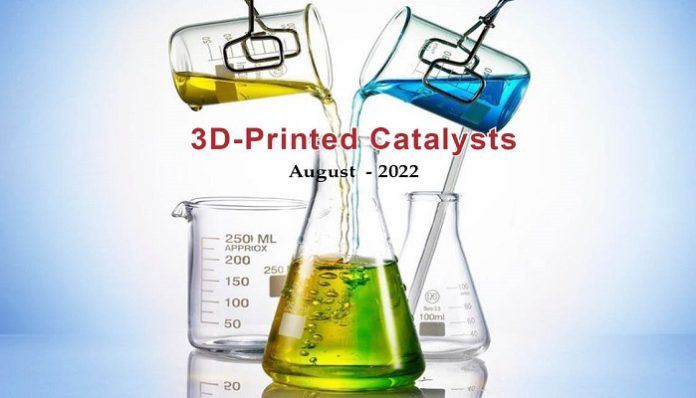3D-printing which has found applications in a wide variety of fields has also been recently used to manufacture catalysts with novel architectures. These morphologies offer improved transport properties at lower energy requirements. Catalysts can also be customised for specific and unique outcomes that are not possible with conventional catalysts.
Hideo Kodama is widely regarded as the inventor of 3D Printing in 1981. He came up with a layer-by-layer technique for rapid prototyping using a photosensitive resin that was polymerised by UV light. But the honour of developing the first commercial 3D Printer in 1984 goes to Chuck Hull, who copyrighted the term “Stereolithography” for his technique of curing liquid monomers layer by layer. 3D-printing has come a long way in the last four decades and today it is one of the nine pillars of Industry 4.0. ASTM has developed a taxonomy to classify various 3D-printing technologies under seven categories: Binder Jetting, Directed Energy Deposition (DED), Powder Bed Fusion (PBF), Sheet Lamination, Material Extrusion, Material Jetting and Vat Photo Polymerisation. 3D-printing, also known as Additive Manufacturing, have found applications in a wide variety of areas like automotive manufacturing, aerospace engineering, electronics, medicine, construction, art and jewellery. But use of 3D-printing in catalysis is a relatively recent development and is full of exciting possibilities.
Catalysts
Catalysts have traditionally been in the form of granules, pellets and extrudates. Millimetre-sized spherical granules are the most basic catalyst geometry used in fixed bed reactors. Elaborate protocols are adopted to fill such catalysts in reactors to achieve the desired void fraction and to prevent attrition. Pellets are formed by pressing catalyst powder in millimetre-sized moulds with a pressurised die to impart the desired mechanical strength. They have a far more uniform size distribution than spherical granules and offer lower pressure drop for the same mass transfer. Extruded forms, produced by passing a slurry of catalyst and additives through a screw extruder and die, are widely used in the industry, especially in refineries. Extrusion allows for more geometrical variations compared to granules and pellets but the process is limited by the rheological properties of the slurry. Extrudates offer greater flexibility to the designer to vary the surface to volume ratio, which ultimately influences the residence times and pressure drops in the reactor.
Monoliths
Monolithic structures are an interesting alternative to the traditional catalyst forms because of many benefits. They offer lower pressure drops, have higher mechanical and thermal stability and confer improved heat and mass transfer properties over conventional catalysts. Monoliths are essentially uniform blocks consisting of parallel channels. They can be manufactured in various shapes: cylindrical, cubic, hexagonal amongst others. The heat and mass transfer properties and hence the catalytic performance is influenced by the geometries of the channels. An important feature of the monolithic catalysts is the higher void fraction compared to pellets. The lower resistance to flow through the channels allows for high space velocities, which is an useful tool to tweak product selectivity and yield. Honeycomb-shaped monoliths are used within standalone reactors in automobile exhaust clean-up.
Monolithic structures are of two types – ceramic and metallic. They differ greatly in physical and chemical properties. Ceramic monoliths have higher porosity and better thermal stability. Metallic monoliths provide better mechanical stability and heat transfer properties. Monoliths are usually produced from an inert material and subsequently washcoated with catalyst. The washcoat is a secondary support that confers improved adherence and increased dispersion of the active species. Gamma-alumina is a typically used washcoat for monoliths. Washcoating involves repeated cycles of dipping and drying followed by a final calcination.
3D-Printing
Conventional methods of fabricating monoliths lead to either very densely packed beds or very open cellular structures. 3D-printing unlocks opportunities to structure the catalysts in a variety of ways. It could, for example, introduce local variations throughout the catalyst structure. The porosity of the catalyst structure could be locally tuned along both the axial and transverse directions. Multiple materials could be used within one printed structure to alter the catalyst performance in many different permutations and combinations. 3D-printing overcomes the limitations of conventional shaping methods and allows for customisation of structures to suit specific operating parameters. Computer Aided Design (CAD) coupled with 3D-printing makes it possible to develop unique monolithic structures which would otherwise be impossible using conventional techniques.
The active catalytic material can be integrated with the monolithic structure during the 3D-printing stage itself or separately deposited on the printed objects. Many catalysts require a finishing step, which usually consists of drying and sintering to remove the binders and decompose the precursors. Other finishing processes involve reduction of metal ions. 3D-printing has been used to produce monolithic structures from doped polymeric materials, carbon materials, metals, metal oxides and zeolites. The performance of such 3D-printed catalysts have been studied extensively in many processes and the results have been more than encouraging. One limitation for 3D-printing is in the use of ceramic materials and they are yet to be deployed on a commercial scale.
Robocasting
Robocasting, also known as robotic material extrusion, was the first technique for 3D-printing monolithic structures. Metal-organic frameworks (MOF) are among the best materials for catalysts and adsorbents, and a critical problem in their design is finding the best compromise between porosity and mechanical strength for a specific application. Robocasting has been used to produce MOF solids with controlled morphology and superior textural properties. The technique has been used to produce zeolite-based catalysts for application in methanol to olefins conversion. The 3D-printed structure with zigzag channels exhibited improved activity and higher stability than a conventionally fabricated monolith with parallel channels.
Digital Light Processing
Digital Light Processing (DLP), one of the most promising 3D-printing technologies, has been used for indirect synthesis of monolithic structures. DLP is a type of vat polymerisation using photopolymers that can be cured with a light source. DLP is used to print templates of polymeric materials, which are then filled with ceramic pastes containing active catalytic materials. The filled templates are then dried and calcined to remove the polymeric material and set the ceramic structure. The DLP technique allows to build customised templates for a very specific purpose and then replicate them into monolithic architectures with unmatched precision.
Epilogue
Currently, 3D-printing of catalysts is more expensive and labour-intensive than conventional processes for the shaping of these materials. The additional investment has to be economically offset by lower operating costs due to reduced pressure drop. Savings can also result from customising performance which will reduce the catalyst requirement and reactor volume for the same conversion and yield.
Readers’ responses may be sent to:
k.sahasranaman@gmail.com or
chemindigest@gmail.com
































